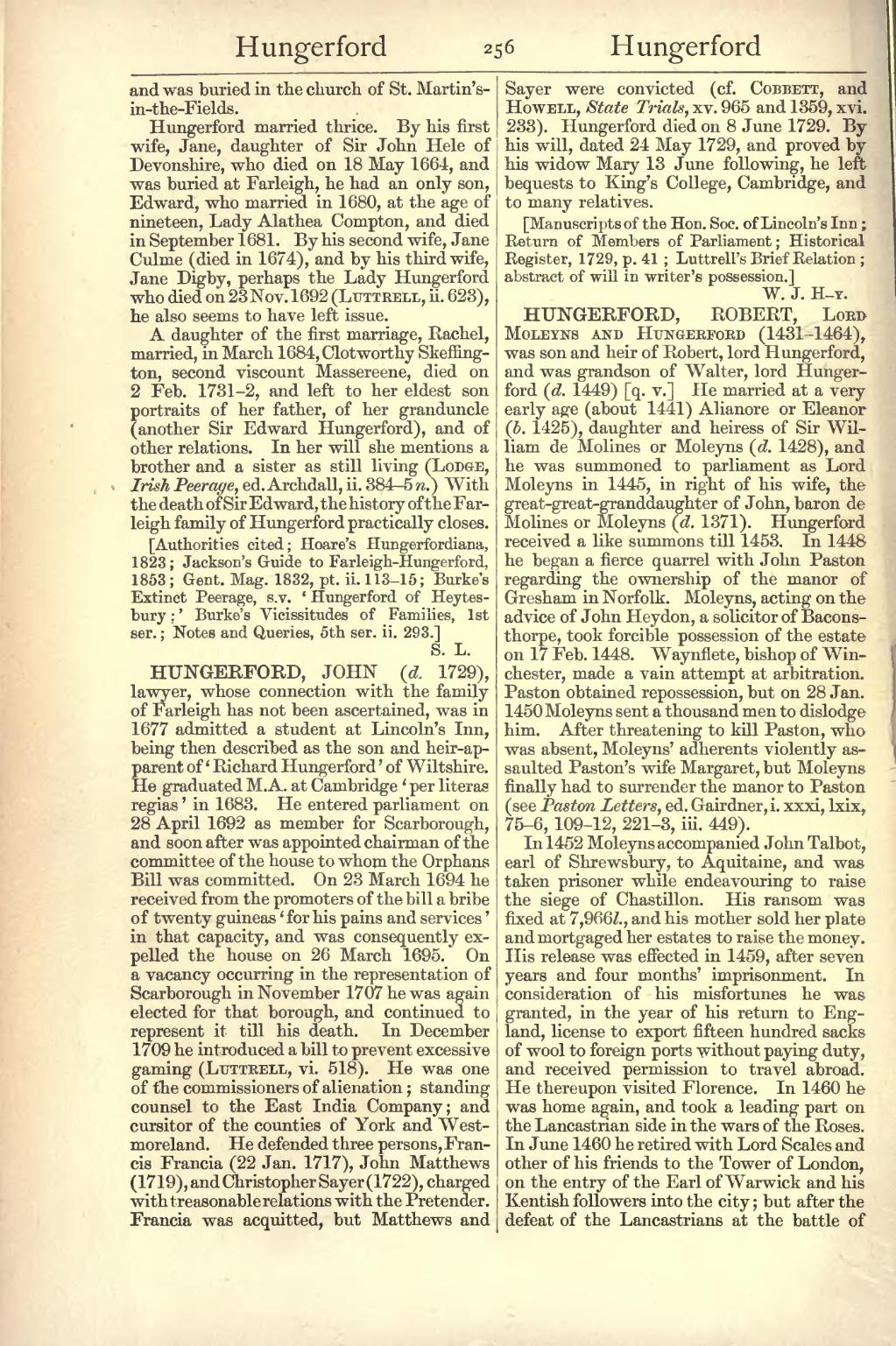and was buried in the church of St. Martin's-in-the-Fields.
Hungerford married thrice. By his first wife, Jane, daughter of Sir John Hele of Devonshire, who died on 18 May 1664, and was buried at Farleigh, he had an only son, Edward, who married in 1680, at the age of nineteen, Lady Alathea Compton, and died in September 1681. By his second wife, Jane Culme (died in 1674), and by his third wife, Jane Digby, perhaps the Lady Hungerford who died on 23 Nov. 1692 (Luttrell, ii. 623), he also seems to have left issue.
A daughter of the first marriage, Rachel, married, in March 1684, Clotworthy Skeffington, second viscount Massereene, died on 2 Feb. 1731-2, and left to her eldest son portraits of her father, of her granduncle (another Sir Edward Hungerford), and of other relations. In her will she mentions a brother and a sister as still living (Lodge, Irish Peerage, ed. Archdall, ii. 384-5 n.) With the death of Sir Edward, the history of the Farleigh family of Hungerford practically closes.
[Authorities cited; Hoare's Hungerfordiana, 1823; Jackson's Guide to Farleigh-Hungerford, 1853; Gent. Mag. 1832, pt. ii. 113-15; Burke's Extinct Peerage, s.v. 'Hungerford of Heytesbury;' Burke's Vicissitudes of Families, 1st ser.; Notes and Queries, 5th ser. ii. 293.]
HUNGERFORD, JOHN (d. 1729), lawyer, whose connection with the family of Farleigh has not been ascertained, was in 1677 admitted a student at Lincoln's Inn, being then described as the son and heir-apparent of 'Richard Hungerford' of Wiltshire. He graduated M.A. at Cambridge 'per literas regias' in 1683. He entered parliament on 28 April 1692 as member for Scarborough, and soon after was appointed chairman of the committee of the house to whom the Orphans Bill was committed. On 23 March 1694 he received from the promoters of the bill a bribe of twenty guineas 'for his pains and services' in that capacity, and was consequently expelled the house on 26 March 1695. On a vacancy occurring in the representation of Scarborough in November 1707 he was again elected for that borough, and continued to represent it till his death. In December 1709 he introduced a bill to prevent excessive gaming (Luttrell, vi. 518). He was one of the commissioners of alienation; standing counsel to the East India Company; and cursitor of the counties of York and Westmoreland. He defended three persons, Francis Francia (22 Jan. 1717), John Matthews (1719), and Christopher Sayer (1722), charged with treasonable relations with the Pretender. Francia was acquitted, but Matthews and Sayer were convicted (cf. Cobbett, and Howell, State Trials, xv. 965 and 1359, xvi. 233). Hungerford died on 8 June 1729. By his will, dated 24 May 1729, and proved by his widow Mary 13 June following, he left bequests to King's College, Cambridge, and to many relatives.
[Manuscripts of the Hon. Soc. of Lincoln's Inn; Return of Members of Parliament; Historical Register, 1729, p. 41; Luttrell's Brief Relation; abstract of will in writer's possession.]
HUNGERFORD, ROBERT, Lord Moleyns and Hungerford (1431–1464), was son and heir of Robert, lord Hungerford, and was grandson of Walter, lord Hungerford (d. 1449)[q.v.] He married at a very early age (about 1441) Alianore or Eleanor (b. 1425), daughter and heiress of Sir William de Molines or Moleyns (d. 1428), and he was summoned to parliament as Lord Moleyns in 1445, in right of his wife, the great-great-granddaughter of John, baron de Molines or Moleyns (d. 1371). Hungerford received a like summons till 1453. In 1448 he began a fierce quarrel with John Paston regarding the ownership of the manor of Gresham in Norfolk. Moleyns, acting on the advice of John Heydon, a solicitor of Baconsthorpe, took forcible possession of the estate on 17 Feb. 1448. Waynflete, bishop of Winchester, made a vain attempt at arbitration. Paston obtained repossession, but on 28 Jan. 1450 Moleyns sent a thousand men to dislodge him. After threatening to kill Paston, who was absent, Moleyns' adherents violently assaulted Paston's wife Margaret, but Moleyns finally had to surrender the manor to Paston (see Paston Letters, ed. Gairdner, i. xxxi, lxix, 75-6, 109-12, 221-3, iii. 449).
In 1452 Moleyns accompanied John Talbot, earl of Shrewsbury, to Aquitaine, and was taken prisoner while endeavouring to raise the siege of Chastillon. His ransom was fixed at 7,966l., and his mother sold her plate and mortgaged her estates to raise the money. His release was effected in 1459, after seven years and four months' imprisonment. In consideration of his misfortunes he was granted, in the year of his return to England, license to export fifteen hundred sacks of wool to foreign ports without paying duty, and received permission to travel abroad. He thereupon visited Florence. In 1460 he was home again, and took a leading part on the Lancastrian side in the wars of the Roses. In June 1460 he retired with Lord Scales and other of his friends to the Tower of London, on the entry of the Earl of Warwick and his Kentish followers into the city; but after the defeat of the Lancastrians at the battle of
